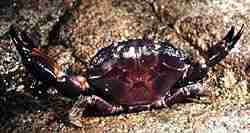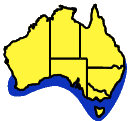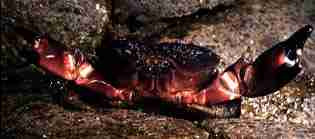|
|
Reef Crab Ozius truncatus
Form:
The carapace of the Reef Crab is broadly oval with a wide front.
The carapace is flattened above, covered with sparse hairs, granules and distinct knobs. There are small, but distinct tubercles on the front edge and sides of the carapace. The chelae are uneven in size. This is especially so in old males, where one chelae may be as long as the carapace is wide.
Colour:

The
carapace colour of the Reef Crab varies from dull white in juveniles,
to rusty brown with olive shades, mottled with dark brown, in the adults.
The end of the chelae is distinctively marked with dark brown to black,
with lighter coloured tips to the fingers.
Phylum: |
Arthropoda |
Author: |
M. Edwards |
Family: |
Menippidae |
Size: |
50-80 mm |
Distribution:
 Its
range includes Southern Queensland, New South Wales, through Victoria,
Tasmania, South Australia and southern Western Australia.
Its
range includes Southern Queensland, New South Wales, through Victoria,
Tasmania, South Australia and southern Western Australia.
Habitat:
The Reef Crab is found at low tide and below on rocky ocean shores, usually under loose rocks and boulders.
Biology:
The Reef Crab is a very common crab. It appears to be gentle species and does not attempt to defend itself, even though its claws are large and appear menacing. If touched, it may pretend to be dead, with its hind legs stuck out at the rear in a very unusual posture.
I have seen this crab eating "Blue Bottle's" washed up on the shore. Some crabs can store the undischarged nematocysts which makes the crab "poisonous" to eat by predators. I am not sure whether this crab does this.
References:
Bennett, I. (1987) W.J. Dakin's classic study: Australian Seashores. p.223, Angus & Robertson, Sydney.
Davey, K. (1998) A Photographic Guide to Seashore Life of Australia. p.51, New Holland, Sydney.
Edgar, G.J. (1997) Australian Marine Life: the plants and animals of temperate waters. p.211, Reed Books, Kew.
Jones, D. & Morgan, G. (1984) A Field Guide to Crustaceans of Australian Waters. p.176, Reed.
Underwood, A.J. & Chapman, M.G. (1993) Seashores: a beachcomber's guide. p.44, New South Wales University Press, Sydney.
Crabs
Tubercled
Crab
Reef Crab
Smooth-handed Crab
Variegated
Shore Crab
Red Bait Crab
Sowrie Crab
Mudflat Sentinal Crab
Smooth Shore Crab
Seaweed-decorator
Crab
Crab
reproduction
Crab parasitism
Home
Page
Taxonomy
Biogeography
Rocky Shores
Tidal Levels
Intertidal Zonation
Environmental Factors
Biological
Factors
Feeding Relationships
Activities
Glossary
References
 Life
on Australian Seashores
Life
on Australian Seashores
by Keith Davey (C) 2000
Learning Consultant
- Media
The University of Newcastle
email at australian_seashores@hotmail.com
Scientific Consultant: Phil
Colman
site created 01.01.98 : updated 01.04.2000

